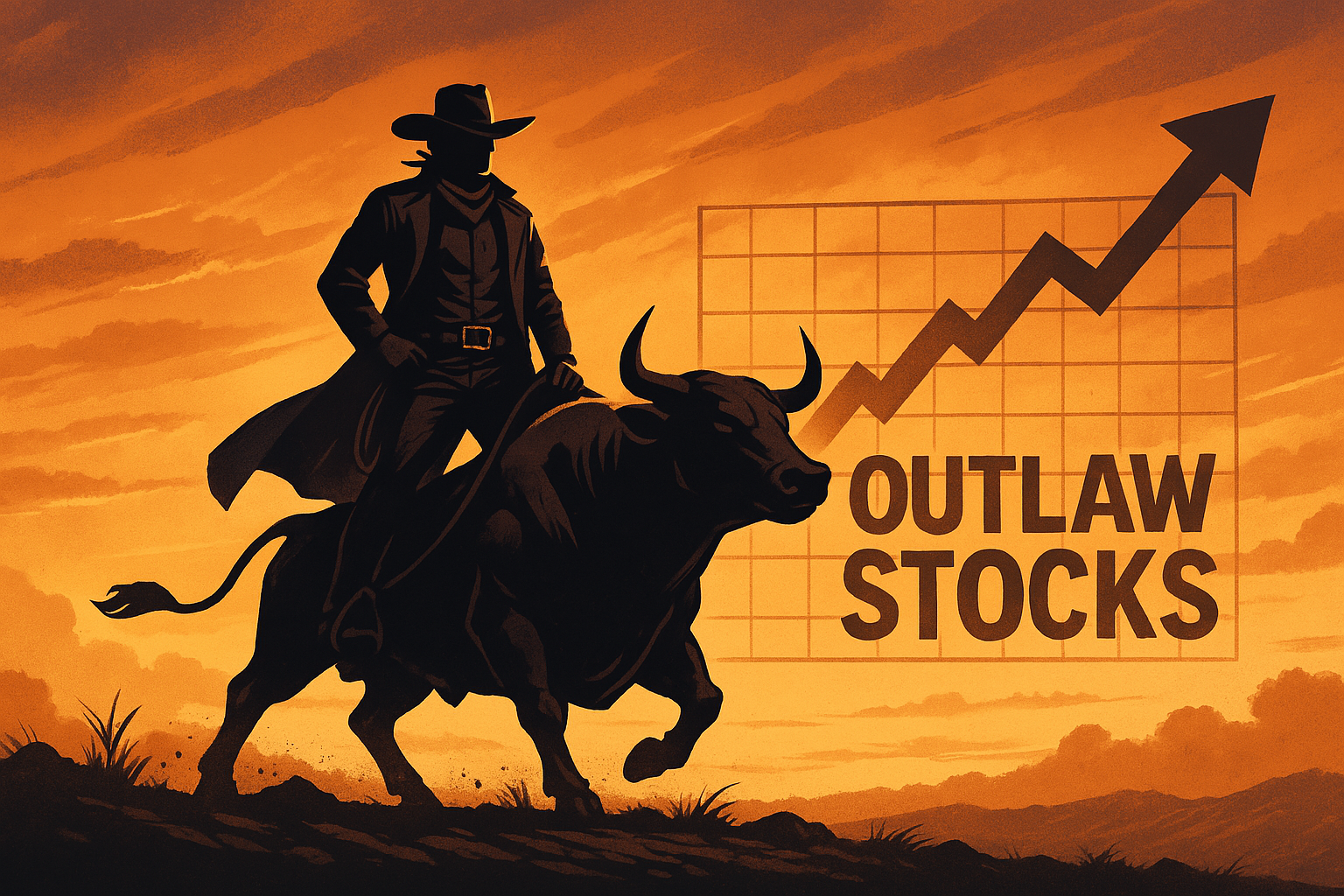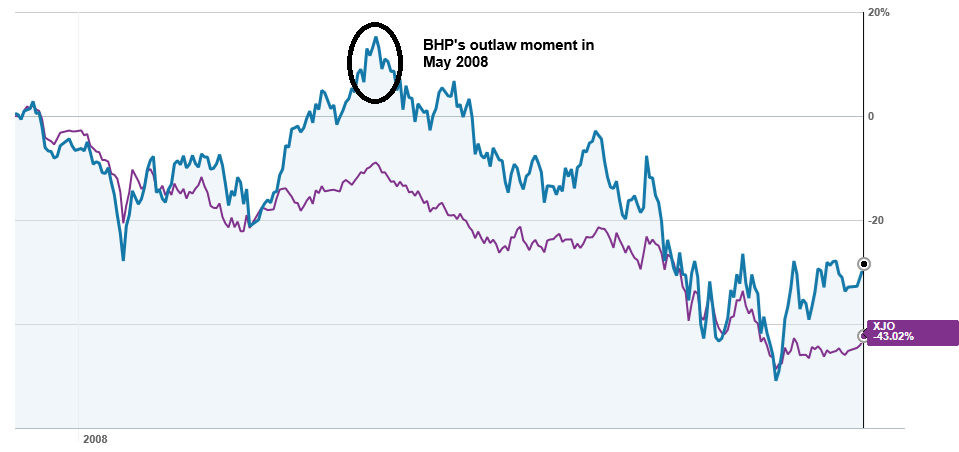The Outlaw Stocks: The ASX names defying the sell-off and hitting 52-week highs
In every market downturn, a few renegades emerge - stocks that climb while everything else sinks. For investors like us, watching these outliers soar as the rest of our portfolio bleeds can feel almost criminal.
So, let’s give them a name: The Outlaw Stocks.
These are the companies and ETFs setting new 52-week highs while the rest of the market wobbles. It’s a tongue-in-cheek label, sure, but also a fitting one as it involves gold and risky leveraged funds.
To find the ASX investments that became Outlaws since Liberation Day, we used the 52-week highs screener from our sister site, Market Index, and reviewed stocks that were setting fresh records as of Friday, 4 April and again Monday afternoon, 7 April. You can download the full list of Outlaw Stocks at the end of this wire.
We’ve grouped them into key themes to unpack why they’re performing so well, whether the trend has legs - or if it’s a momentum trap - and which names fund managers are backing (or bailing on).

Defensive royalty
Healthcare-insurance and consumer staples are doing what they do best: delivering stability when the rest of the market looks wobbly. Coles and Medibank are arguably the main Outlaws here: boring, dependable, and outperforming.
| Code | Company | Price | YTD % | Market cap |
|---|---|---|---|---|
| ASX: COL | Coles Group Ltd | $21.13 | +27.4% | $28.3B |
| ASX: MPL | Medibank Private | $4.63 | +23.5% | $12.8B |
Performance data as at 4 April (source: Market Index)
Tyndall's Craig Young believes the surge in Coles shares reflects a broader flight to quality since the announcement of new tariffs.
"These disruptions to global trade are expected to push economic growth lower and inflation higher. Supermarkets have some of the most defensive revenues on the ASX and are better positioned to pass on inflation through pricing," he says.
He sees continued upside in Coles.
"Coles is performing well, as it has long had a plan to improve performance and close the gap to competitor Woolworths. Coles has managed its supply chain improvement plan well, with further benefits expected to flow from this area," he says.
"Until Woolworths has concrete and deliverable plans to improve, Coles appears set to continue to outperform."
Collins St Asset Management's Michael Goldberg agrees Coles is winning investor favour but remains cautious.
“It’s too expensive for our liking, but I can see why it’s attracting capital," he says.
As for Medibank, he notes: “MPL is simply benefiting from being in a defensive industry. They also have a $3.7 billion float - if that’s invested in bonds, it could be helping.”
Gold miners and ETFs
Spot gold is flying - and so are the miners. Some of the ASX’s biggest year-to-date winners are now gold names.
| Code | Company | Price | YTD % | Market Cap |
| RRL | Regis Resources Ltd | $4.06 | +104.5% | $3.07B |
| GOR | Gold Road Resources | $3.01 | +83.0% | $3.27B |
| CMM | Capricorn Metals Ltd | $8.47 | +54.3% | $3.65B |
| DEG | De Grey Mining Ltd | $2.17 | +68.1% | $5.2B |
| NST | Northern Star Resources | $18.85 | +27.5% | $21.57B |
| NUGG / GLDN GXLD / PMGOLD |
Physical gold ETFs | – | +42–46% | – |
Performance data as at 4 April; gold ETFs as at 7 April (source: Market Index)
Goldberg says the gold rally is being fuelled by a perfect storm of tailwinds.
"Given record demand for gold (most of that growth coming from reserve banks and investment), global unrest, a shift away from the USD as the prefered reserve currency for certain nations, and the now top of the news tariff wars, the tailwinds for gold (as a commodity) are strong," he says.
"On top of the general tailwinds for the commodity, most gold stocks have massively underperformed what you would expect given the massive increase in their earnings and potential.
"Both L1 and Collins St called out this dislocation as the key reasons we launched our funds."
In the following wire, Goldberg provides an extensive thesis on gold and nominates which specific parts of the gold market could be the next to shine in the rally.

His top performers have been Outlaw Stocks which hit 52-week highs last week: Catalyst Metals ASX: CYL), Black Cat Syndicate (ASX: BC8, and Meeka Metals (ASX: MEK).
But in the following wire, Chris Leithner of Leithner & Company, challenges the idea that all that glitters is gold, arguing against an asset class he says has "repeatedly succumbed to cycles of dizzying boom and devastating bust."

Bond ETFs
As the market prices in weaker growth and potential rate cuts, bond ETFs are quietly rallying.
| Code | Company | Price | YTD % | Market Cap |
| VAF | Vanguard Australian Fixed Interest ETF | $46.31 | +2.2% | $2.44B |
| VACF | Vanguard Australian Corporate Fixed Interest ETF | $51.68 | +3.0% | $675M |
| VGB | Vanguard Australian Government Bond ETF | $47.13 | +1.9% | $1.1B |
| CRED | Betashares Investment Grade Corp Bond ETF | $23.39 | +3.1% | $1.13B |
| ICOR | iShares Core Corporate Bond ETF | $96.67 | +2.2% | $281.6M |
| AEBD | Betashares Ethical Australian Composite Bond ETF | $51.60 | +3.1% | $43.3M |
Performance data as at 4 April and 7 April (source: Market Index)
“Bond ETFs are up because markets are pricing in up to five rate cuts this year. Since bond prices move inversely to yields, that’s giving these funds a lift," Goldberg says.
But why are bond markets pricing in more rate cuts...if tariffs are inflationary?
Charlie Jamieson, Co-Founder of Jamieson Coote Bonds, tackled this critical question in our latest Rules of Investing podcast.
He noted that while higher prices can be offset by demand destruction, slowing global growth - driven by ongoing trade wars - may prompt central banks to cut rates in an effort to protect economic growth.

Tyndall's Young says gold and bond ETFs will likely continue to shine amid the uncertainty.
"While the risks of recession and higher inflation remain in place, yes, it’s reasonable to assume that they will continue to outperform. The uncertainty around US policy and around global trade is likely to remain elevated for some time, meaning the demand for safer-haven assets will continue to be high," he says.
Leveraged and inverse ETFs
These Outlaws are designed for market pain, and business is booming.
| Code | Company | Price | YTD % | Market Cap |
| SNAS | Global X Ultra Short Nasdaq ETF | $38.66 | +11.4% | $106.5M |
| BBUS | Betashares US EQY Strong Bear ETF | $6.48 | +10.2% | $189.2M |
| BBOZ | Betashares Aus Equities Strong Bear | $33.36 | +15.8% | $263.0M |
| BEAR | Betashares Aus Equities Bear ETF | $8.66 | +8.9% | $51.5M |
“BEAR is designed to go up when the ASX goes down,” Goldberg explains.
“It’s not a perfect match, but short term, it does the job. Today the ASX is down 3.8% and BEAR is up about the same.”
A note of caution for Outlaw chasers
While Outlaw Stocks might seem invincible right now, history reminds us that momentum can fade quickly - especially if we descend into a prolonged bear market or a global recession.
"Momentum is easier to trust in a stable environment when the dominant thematic remains constant," Young says.
"If we continue to see disruptions to trade and growth then momentum might be of value as long as the predominant thematic in the market remains the same. Due to the unpredictability of US policy, it is difficult to have confidence that the issues will remain the same."
It’s important to remember that chasing stocks hitting 52-week highs isn’t a guaranteed strategy. If economic conditions deteriorate further (think rising unemployment, slowing growth, or prolonged volatility) a broader set of stocks could be swept up in the downturn.
Take the Global Financial Crisis as a case study. When the ASX 200 started sliding in December 2007, investors continued backing names like BHP as they believed its fortunes were tied more to China's growth than the chaos in the US.

But when the US sneezed, the rest of the world caught a severe cold. Economic demand collapsed, and BHP eventually succumbed to downdraft of the market.
The lesson? Some Outlaws aren't bulletproof.
So while many of the stocks above are seeing strong fundamental or macro tailwinds today, the backdrop can change fast. Investors should ask: is this breakout built on momentum alone or on something more durable?
3 topics
2 contributors mentioned

